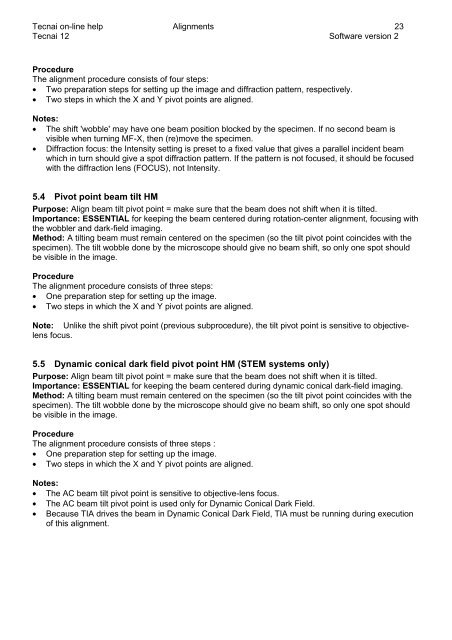Tecnai on-line help manual -- Alignments - UT Southwestern
Tecnai on-line help manual -- Alignments - UT Southwestern
Tecnai on-line help manual -- Alignments - UT Southwestern
- No tags were found...
Create successful ePaper yourself
Turn your PDF publications into a flip-book with our unique Google optimized e-Paper software.
<str<strong>on</strong>g>Tecnai</str<strong>on</strong>g> <strong>on</strong>-<strong>line</strong> <strong>help</strong> <strong>Alignments</strong> 23<str<strong>on</strong>g>Tecnai</str<strong>on</strong>g> 12 Software versi<strong>on</strong> 2ProcedureThe alignment procedure c<strong>on</strong>sists of four steps:• Two preparati<strong>on</strong> steps for setting up the image and diffracti<strong>on</strong> pattern, respectively.• Two steps in which the X and Y pivot points are aligned.Notes:• The shift 'wobble' may have <strong>on</strong>e beam positi<strong>on</strong> blocked by the specimen. If no sec<strong>on</strong>d beam isvisible when turning MF-X, then (re)move the specimen.• Diffracti<strong>on</strong> focus: the Intensity setting is preset to a fixed value that gives a parallel incident beamwhich in turn should give a spot diffracti<strong>on</strong> pattern. If the pattern is not focused, it should be focusedwith the diffracti<strong>on</strong> lens (FOCUS), not Intensity.5.4 Pivot point beam tilt HMPurpose: Align beam tilt pivot point = make sure that the beam does not shift when it is tilted.Importance: ESSENTIAL for keeping the beam centered during rotati<strong>on</strong>-center alignment, focusing withthe wobbler and dark-field imaging.Method: A tilting beam must remain centered <strong>on</strong> the specimen (so the tilt pivot point coincides with thespecimen). The tilt wobble d<strong>on</strong>e by the microscope should give no beam shift, so <strong>on</strong>ly <strong>on</strong>e spot shouldbe visible in the image.ProcedureThe alignment procedure c<strong>on</strong>sists of three steps:• One preparati<strong>on</strong> step for setting up the image.• Two steps in which the X and Y pivot points are aligned.Note: Unlike the shift pivot point (previous subprocedure), the tilt pivot point is sensitive to objectivelensfocus.5.5 Dynamic c<strong>on</strong>ical dark field pivot point HM (STEM systems <strong>on</strong>ly)Purpose: Align beam tilt pivot point = make sure that the beam does not shift when it is tilted.Importance: ESSENTIAL for keeping the beam centered during dynamic c<strong>on</strong>ical dark-field imaging.Method: A tilting beam must remain centered <strong>on</strong> the specimen (so the tilt pivot point coincides with thespecimen). The tilt wobble d<strong>on</strong>e by the microscope should give no beam shift, so <strong>on</strong>ly <strong>on</strong>e spot shouldbe visible in the image.ProcedureThe alignment procedure c<strong>on</strong>sists of three steps :• One preparati<strong>on</strong> step for setting up the image.• Two steps in which the X and Y pivot points are aligned.Notes:• The AC beam tilt pivot point is sensitive to objective-lens focus.• The AC beam tilt pivot point is used <strong>on</strong>ly for Dynamic C<strong>on</strong>ical Dark Field.• Because TIA drives the beam in Dynamic C<strong>on</strong>ical Dark Field, TIA must be running during executi<strong>on</strong>of this alignment.
















